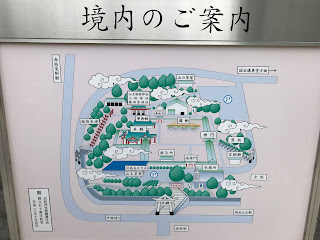As their trip winds up in a couple of days, I asked my cousins if there was something they really wanted to see in Japan before they left. They told me they wanted to see red toriis like they have in Kyoto. After a quick search they found there are two shrines in Tokyo with red torii gates - Nezu Jinja and Hie Jinja. (Jinja means shrine in Japanese.)
Since we have limited time to visit places on school days (I need to be back in time to pick up my son from school), we picked the shrine closest to our house. It only reduced the travel time by 10 minutes, but that is more time exploring which is what really matters.
I was glad to learn that the closer shrine was one I had never explored. Hie Jinja (he-ay jin-ja) is nestled in the middle of Nagatacho, where Japanese government is busy working. This neighborhood houses the National Diet (Parliament) buildings and even the home of the Prime Minister. In between all the cement buildings and security guards is a city block covered in a lush landscape with several sacred buildings hiding up on top of a hill.
We followed Google Maps out exit 1 of Nagatacho Station and walked just two blocks to the shrine. We were greeted with stairs up to the main shrine.
Walking in, I immediately notices the monkey statues and images on the ema (wooden placards to write wishes on). Within Shinto, monkeys are known as messengers, communicating prayers from people to the Gods. At Hie Jinja, the monkeys convey wishes of removal of bad fortune or evil as well as prayers for amicable relationships within marriages.
The shrine's main deity is Oyamakui-no-kami. It exists in Mount Hie near Kyoto. People come to pray to this god to wish for avoiding bad fortune, match-making, conceiving a child, and safe child birth.
Although we did pray to the deity and ask for guidance, we were mainly there to see the red toriis. As we walked around the grounds, we didn't see them. We even peaked around some corners to see if they were hidden.
Just as we were about to give up, I saw a sign with a map. It turns out we did not enter through the main entrance to the shrine. We should have taken either exit 6 or 8 from the subway to arrive at the main entrance, indicated with the big black torii. It is the same distance from the station, it just takes you to a different entrance to the shrine. The red toriis are accessible by any gate, it is just easiest to find when entering the main gate.
After walking under the main torii gate, there is a set of stairs on the left. They are a little hidden in the retaining wall, but they are easily spotted when going in that direction. Up these couple of steps, there is a turn, and then the row of red toriis. Every time I see them, it takes my breath away. There is something so calming about walking through them.
I was impressed by how few people there were walking under the red torii gates. We have been to Fushimi Inari Taisha Shrine in Kyoto and Nezu Jinja in Tokyo. Both were pretty crowded in parts, especially where the toriis were located. But here, we only saw 5 other people on the hill. One of the other visitors made the same comment regarding the lack of congestion at the shrine. It is always so nice when you find a little slice of solitude within Tokyo - especially if it has red accents.
In 2017 my family headed to Tokyo. My husband had a new job and my son and I came along for the ride. This move was my second move to Japan - the first was for a year in 2002. At that time I was a single, recent college graduate. Moving abroad as a family was a whole different ball of wax. As I live this crazy life in Japan, I track our adventures and my observations, creating an unofficial guidebook to the city.
Subscribe to:
Post Comments (Atom)
The time has come to say goodbye
Earlier this year my husband applied for a new job. As usual, I encouraged him as he went through the interview process. It was a long, draw...

-
I need to renew my passport. It is hard to believe that another 10 years have passed and it is time to get a new book that travels around t...
-
I was able to take a bit of time for myself today and join a group chat of moms. While my husband worked and my son watched a couple episod...

















No comments:
Post a Comment